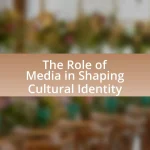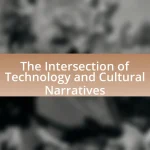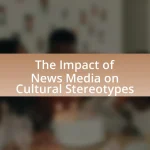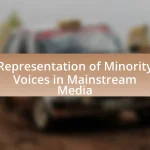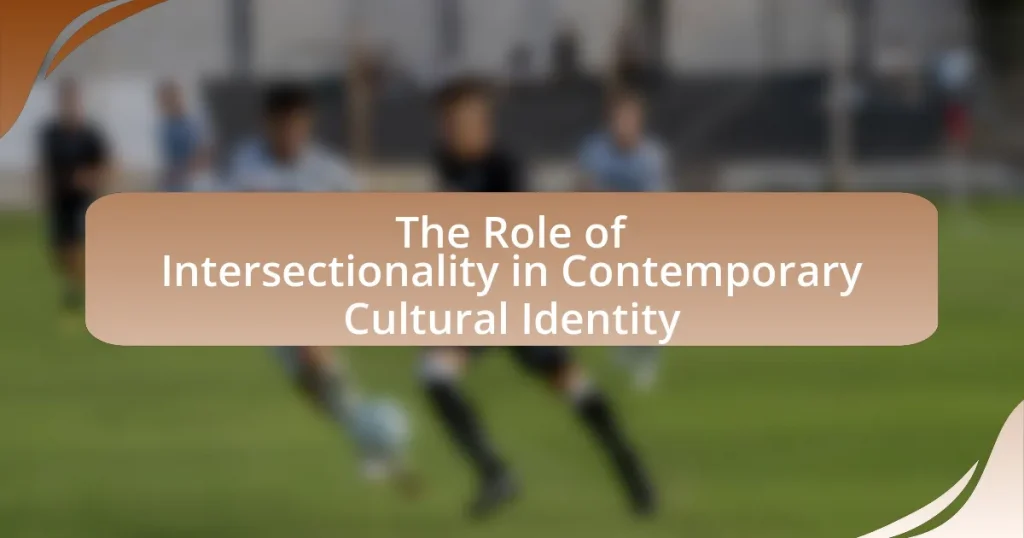The article examines the role of intersectionality in shaping contemporary cultural identity, emphasizing how overlapping social categories such as race, gender, sexuality, and class create unique experiences of oppression and privilege. It discusses the significance of intersectionality in cultural identity formation, highlighting its impact on social justice movements and the representation of marginalized groups. Key components include the interconnectedness of identities and the challenges faced by individuals at these intersections, as illustrated by research from Kimberlé Crenshaw. The article also addresses critiques of intersectionality and offers practical steps for individuals to embrace this framework in understanding their cultural identities.
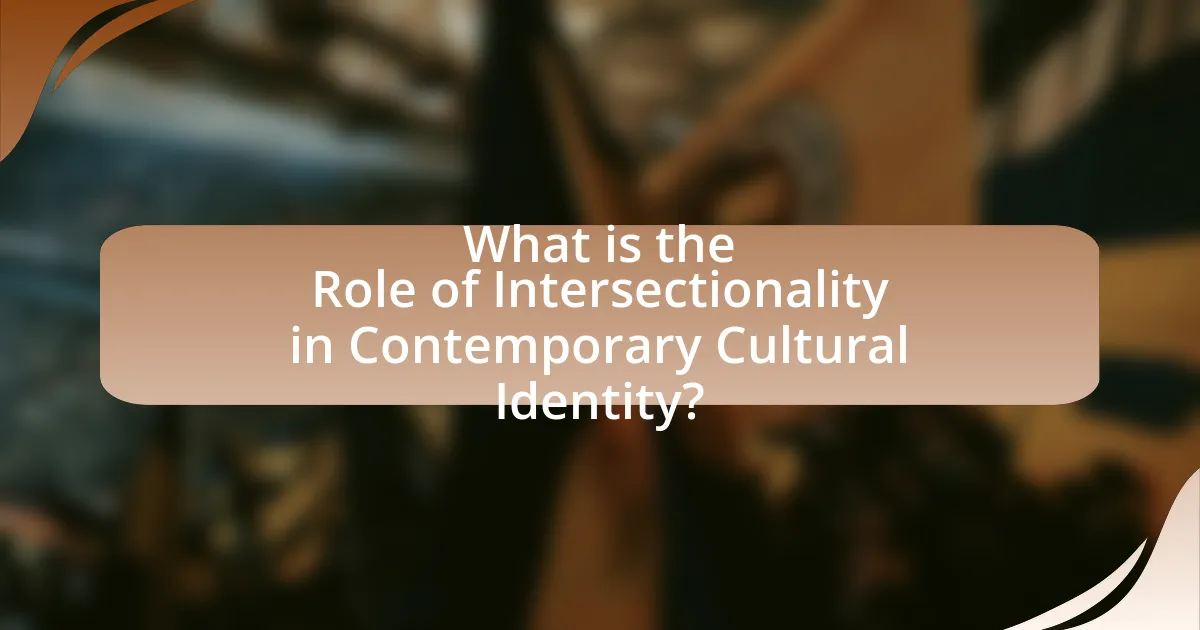
What is the Role of Intersectionality in Contemporary Cultural Identity?
Intersectionality plays a crucial role in shaping contemporary cultural identity by highlighting how various social categories, such as race, gender, sexuality, and class, intersect to create unique experiences of oppression and privilege. This framework allows for a more nuanced understanding of identity, acknowledging that individuals do not experience discrimination or advantage based solely on one aspect of their identity but rather through the complex interplay of multiple identities. For instance, a study by Crenshaw (1989) introduced the term “intersectionality” to illustrate how Black women face distinct challenges that are not fully captured by examining race or gender in isolation. This perspective is essential in contemporary discussions about social justice, as it informs activism and policy-making by recognizing the diverse experiences within marginalized communities.
How does intersectionality influence cultural identity formation?
Intersectionality significantly influences cultural identity formation by recognizing how overlapping social identities, such as race, gender, class, and sexuality, interact to shape individual experiences and perspectives. This framework allows for a more nuanced understanding of identity, as it highlights that individuals do not experience oppression or privilege in isolation but rather through a complex interplay of their various identities. For instance, a study by Crenshaw (1989) introduced the concept of intersectionality, illustrating how Black women face unique challenges that differ from those experienced by white women or Black men, thereby emphasizing the importance of considering multiple identity factors in cultural identity formation. This understanding fosters a more inclusive approach to cultural identity, acknowledging diverse experiences and promoting social justice.
What are the key components of intersectionality in this context?
The key components of intersectionality in the context of contemporary cultural identity include the interconnectedness of social categorizations such as race, gender, class, and sexuality, which create overlapping systems of discrimination or disadvantage. This framework emphasizes that individuals experience multiple identities simultaneously, influencing their social experiences and access to resources. For example, a study by Crenshaw (1989) highlights how Black women face unique challenges that are not fully understood when considering race or gender in isolation. This illustrates that intersectionality is crucial for understanding the complexities of identity and social justice in today’s society.
How do various identities intersect to shape individual experiences?
Various identities intersect to shape individual experiences by creating unique social positions that influence access to resources, opportunities, and social interactions. For instance, a person’s race, gender, socioeconomic status, and sexual orientation can combine to affect their experiences of discrimination or privilege. Research by Kimberlé Crenshaw, who coined the term “intersectionality,” illustrates how individuals with multiple marginalized identities face compounded disadvantages, such as higher rates of poverty and violence. This framework highlights that understanding individual experiences requires acknowledging the complexity of identity and the systemic structures that impact those identities.
Why is understanding intersectionality important in cultural studies?
Understanding intersectionality is important in cultural studies because it provides a framework for analyzing how various social identities, such as race, gender, class, and sexuality, intersect to shape individual experiences and societal structures. This approach reveals the complexities of power dynamics and social inequalities, allowing scholars to better understand the multifaceted nature of identity and oppression. For instance, Kimberlé Crenshaw, who coined the term “intersectionality,” highlighted how Black women face unique challenges that are not fully addressed by examining race or gender in isolation. This insight is crucial for developing inclusive cultural analyses that reflect the diverse realities of marginalized groups.
How does intersectionality challenge traditional cultural narratives?
Intersectionality challenges traditional cultural narratives by highlighting the interconnectedness of various social identities, such as race, gender, class, and sexuality, which shape individual experiences and perspectives. This framework reveals that traditional narratives often oversimplify or ignore the complexities of identity, leading to a one-dimensional understanding of culture. For instance, Kimberlé Crenshaw, who coined the term “intersectionality,” demonstrated how Black women face unique forms of discrimination that are not adequately addressed by feminist or anti-racist movements alone. By emphasizing these overlapping identities, intersectionality calls for a more nuanced approach to cultural narratives that recognizes the diverse experiences of marginalized groups, ultimately reshaping societal understanding and representation.
What implications does intersectionality have for social justice movements?
Intersectionality significantly influences social justice movements by highlighting the interconnected nature of social categorizations such as race, gender, class, and sexuality. This framework allows activists to understand how overlapping identities contribute to unique experiences of oppression and privilege. For instance, Kimberlé Crenshaw, who coined the term “intersectionality,” demonstrated through her research that Black women face distinct challenges that are not fully addressed by feminist or anti-racist movements alone. By incorporating intersectionality, social justice movements can create more inclusive strategies that address the specific needs of marginalized groups, ultimately leading to more effective advocacy and policy changes.
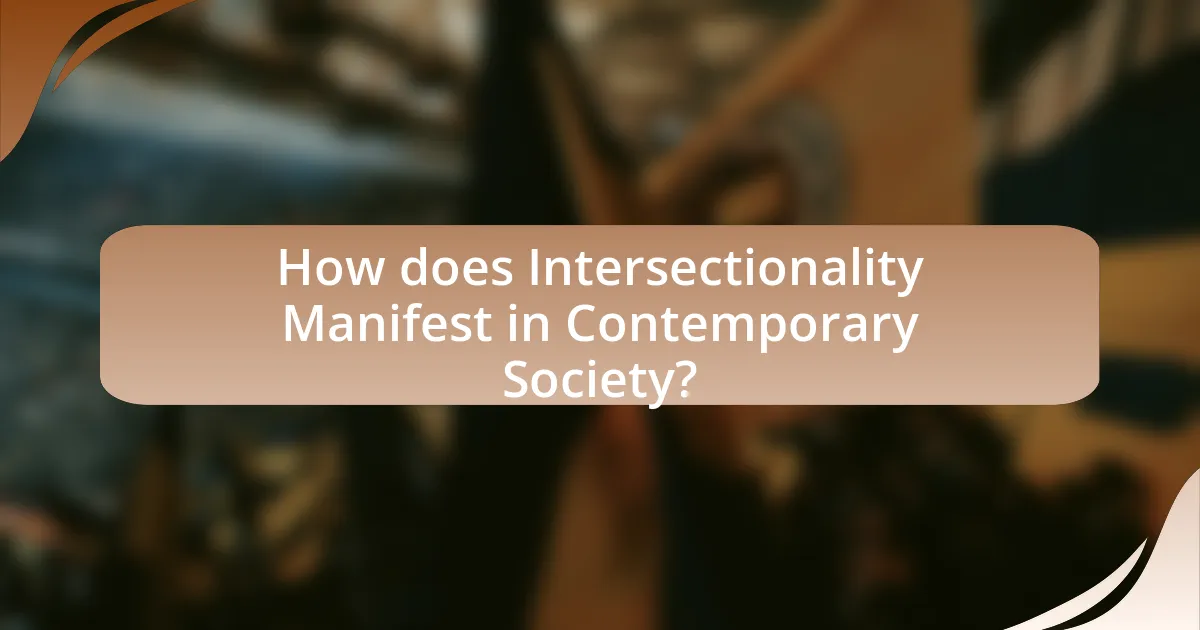
How does Intersectionality Manifest in Contemporary Society?
Intersectionality manifests in contemporary society through the interconnectedness of various social identities, such as race, gender, class, and sexuality, which collectively shape individual experiences and systemic inequalities. For instance, Black women often face unique challenges that differ from those experienced by white women or Black men, as highlighted in the research by Kimberlé Crenshaw, who coined the term “intersectionality” to describe how overlapping identities can lead to compounded discrimination. This concept is evident in various societal structures, including the workplace, where studies show that women of color encounter both gender and racial biases, resulting in lower wages and fewer opportunities for advancement compared to their counterparts. Additionally, intersectionality is reflected in social movements, where activists advocate for policies that address the specific needs of marginalized groups, emphasizing that a one-size-fits-all approach to social justice fails to account for the complexities of individual identities.
What are the real-world examples of intersectionality affecting cultural identity?
Real-world examples of intersectionality affecting cultural identity include the experiences of Black women in the workplace, where they face both racial and gender discrimination, impacting their professional advancement and cultural expression. For instance, studies show that Black women are often perceived through a lens of stereotypes that can hinder their career opportunities, as highlighted in the report “The Double Bind: Race and Gender in the Workplace” by the American Association of University Women. Additionally, LGBTQ+ individuals of color experience unique challenges that intertwine their sexual orientation and racial identity, leading to distinct cultural expressions and community dynamics, as evidenced by research from the Williams Institute, which indicates higher rates of discrimination faced by these individuals compared to their white counterparts. These examples illustrate how intersectionality shapes cultural identity by creating complex layers of experience that influence social interactions and self-perception.
How do race, gender, and class intersect in cultural expressions?
Race, gender, and class intersect in cultural expressions by shaping individuals’ identities and experiences, influencing how they create and interpret art, literature, and media. For instance, cultural expressions often reflect the unique perspectives of marginalized groups, where race can dictate representation, gender can influence narrative voice, and class can affect access to resources and platforms. Research by Patricia Hill Collins in “Black Feminist Thought” highlights how Black women navigate these intersecting identities, producing cultural expressions that challenge dominant narratives and offer alternative viewpoints. This intersectionality enriches cultural discourse, revealing the complexities of identity and the multifaceted nature of societal issues.
What role does intersectionality play in the representation of marginalized groups?
Intersectionality plays a crucial role in the representation of marginalized groups by highlighting how overlapping identities—such as race, gender, sexuality, and class—impact individuals’ experiences and social positioning. This framework allows for a more nuanced understanding of discrimination and privilege, revealing that marginalized individuals do not experience oppression in a vacuum but rather through a complex interplay of various social categories. For instance, a study by Crenshaw (1989) introduced the term “intersectionality” to illustrate how Black women face unique challenges that are not fully addressed by either feminist or anti-racist movements alone. This understanding fosters more inclusive representation in media, policy-making, and social justice initiatives, ensuring that the voices of those at the intersections of multiple marginalized identities are heard and considered.
How do different cultures interpret intersectionality?
Different cultures interpret intersectionality through their unique social, historical, and political contexts, which shape how individuals experience overlapping identities. For instance, in Western contexts, intersectionality often emphasizes the interplay of race, gender, and class, as articulated by scholars like Kimberlé Crenshaw, who coined the term to highlight how these identities can compound discrimination. In contrast, Indigenous cultures may focus on the intersection of land, spirituality, and community identity, viewing these elements as interconnected rather than separate categories. Additionally, in many Asian cultures, intersectionality might be interpreted through the lens of familial roles and societal expectations, where gender and class intersect with cultural heritage. These interpretations reflect the diverse ways in which cultural narratives and power dynamics influence the understanding of identity and social justice across different societies.
What variations exist in the understanding of intersectionality across cultures?
Variations in the understanding of intersectionality across cultures include differing emphases on social categories such as race, gender, class, and sexuality. For instance, in Western contexts, intersectionality often focuses on the interplay of race and gender, as articulated by scholars like Kimberlé Crenshaw, who highlighted how Black women experience discrimination differently than white women or Black men. In contrast, Indigenous cultures may prioritize the intersection of land, identity, and colonial history, emphasizing how these factors shape their social realities. Additionally, in many Asian cultures, intersectionality can intersect with concepts of collectivism and familial obligations, leading to unique interpretations of identity that differ from Western individualism. These cultural variations illustrate that intersectionality is not a one-size-fits-all framework but is influenced by local histories, social structures, and cultural values.
How do cultural contexts influence the application of intersectionality?
Cultural contexts significantly influence the application of intersectionality by shaping how individuals experience and navigate their multiple identities. For instance, in societies with rigid social hierarchies, such as caste systems in India, the intersection of gender, class, and caste can lead to unique forms of discrimination that differ from those experienced in more egalitarian societies. Research by Crenshaw highlights that intersectionality is not merely about recognizing multiple identities but understanding how these identities interact within specific cultural frameworks, affecting access to resources and social justice. Thus, cultural contexts provide the backdrop against which intersectional identities are formed and understood, impacting the effectiveness of advocacy and policy interventions aimed at addressing inequalities.
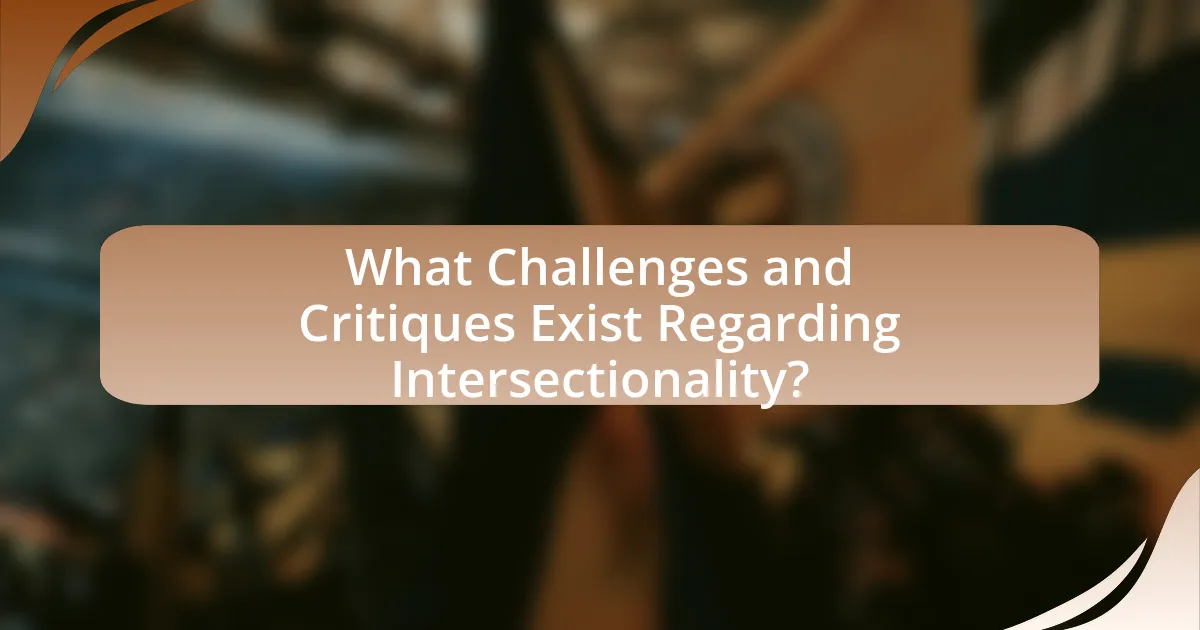
What Challenges and Critiques Exist Regarding Intersectionality?
Intersectionality faces several challenges and critiques, primarily regarding its complexity and practical application. Critics argue that the concept can become overly complicated, making it difficult to implement in policy and activism, as it requires consideration of multiple, often conflicting, social identities simultaneously. Additionally, some scholars contend that intersectionality may dilute the focus on specific forms of oppression, such as racism or sexism, by attempting to address all identities at once, potentially leading to a lack of clarity in advocacy efforts. Furthermore, there are concerns about the potential for intersectionality to be co-opted by mainstream discourse, which can undermine its original intent and reduce its effectiveness in addressing systemic inequalities. These critiques highlight the need for careful consideration of how intersectionality is applied in various contexts to ensure it remains a powerful tool for social justice.
What are the common criticisms of intersectionality in cultural identity discussions?
Common criticisms of intersectionality in cultural identity discussions include its perceived complexity, which some argue makes it difficult to apply in practical contexts. Critics assert that the multifaceted nature of intersectionality can lead to confusion and dilute the focus on specific issues, such as race or gender, by overemphasizing the interplay of various identities. Additionally, some scholars contend that intersectionality may inadvertently reinforce divisions within social movements, as it highlights differences rather than commonalities among marginalized groups. This critique is supported by the observation that intersectionality can create a hierarchy of oppression, where individuals may feel compelled to prioritize certain aspects of their identity over others, potentially leading to fragmentation within advocacy efforts.
How do critics argue against the effectiveness of intersectionality?
Critics argue against the effectiveness of intersectionality by claiming it can lead to fragmentation and a lack of cohesive political action. They assert that focusing on multiple identities may dilute the urgency of addressing systemic inequalities, as highlighted by scholars like Andrew Sullivan, who contends that intersectionality complicates solidarity among marginalized groups. Additionally, some critics, such as Christina Hoff Sommers, argue that intersectionality can foster a victim mentality, which may hinder empowerment and agency among individuals. These critiques suggest that while intersectionality aims to provide a nuanced understanding of oppression, it may inadvertently create divisions that weaken collective efforts for social justice.
What are the potential pitfalls of applying intersectionality in cultural analysis?
The potential pitfalls of applying intersectionality in cultural analysis include oversimplification of complex identities and the risk of essentialism. When intersectionality is applied, there is a tendency to categorize individuals into fixed identity groups, which can obscure the fluidity and uniqueness of personal experiences. This oversimplification can lead to a misunderstanding of how various social categories interact in nuanced ways. Additionally, intersectionality may inadvertently reinforce stereotypes by emphasizing certain identities over others, thus promoting essentialist views that do not account for the diversity within groups. These pitfalls highlight the need for careful and critical application of intersectionality to avoid misrepresentation and to ensure a more accurate understanding of cultural identities.
How can intersectionality be effectively integrated into cultural identity studies?
Intersectionality can be effectively integrated into cultural identity studies by employing a multidimensional framework that examines how various social identities—such as race, gender, sexuality, and class—interact to shape individual experiences and societal structures. This approach allows researchers to analyze the complexities of identity formation and the unique challenges faced by individuals at the intersections of these identities. For instance, studies like “Mapping the Margins” by Kimberlé Crenshaw highlight how Black women experience discrimination differently than either Black men or white women, illustrating the necessity of an intersectional lens in understanding cultural identity. By incorporating intersectionality, cultural identity studies can provide a more nuanced understanding of power dynamics and social inequalities, leading to more inclusive and representative research outcomes.
What best practices should researchers follow when applying intersectionality?
Researchers should prioritize inclusivity and context when applying intersectionality. This involves recognizing and analyzing how various social identities—such as race, gender, class, and sexuality—interact to shape individual experiences and systemic inequalities. For instance, a study by Crenshaw (1989) highlights how Black women face unique challenges that are not fully understood when examining race or gender in isolation. Additionally, researchers should engage with marginalized communities to ensure their perspectives are accurately represented, as demonstrated in the work of Collins (2000), which emphasizes the importance of lived experiences in understanding intersectional dynamics. By adhering to these practices, researchers can produce more nuanced and comprehensive analyses of cultural identity.
How can intersectionality enhance understanding of contemporary cultural issues?
Intersectionality enhances understanding of contemporary cultural issues by revealing how overlapping social identities, such as race, gender, and class, interact to shape individual experiences and systemic inequalities. This framework allows for a more nuanced analysis of cultural phenomena, as it acknowledges that individuals do not experience oppression or privilege in isolation but rather through a complex interplay of their various identities. For instance, studies have shown that Black women face unique challenges that differ from those experienced by white women or Black men, highlighting the importance of considering multiple identity factors in discussions about social justice and cultural representation. By applying intersectionality, scholars and activists can better address the specific needs and perspectives of marginalized groups, leading to more effective advocacy and policy-making.
What practical steps can individuals take to embrace intersectionality in their cultural identity?
Individuals can embrace intersectionality in their cultural identity by actively engaging in self-reflection and education about their own diverse identities and the identities of others. This involves recognizing how various aspects such as race, gender, sexuality, and socioeconomic status intersect and influence experiences. For instance, participating in workshops or reading literature that focuses on intersectional theory can deepen understanding. Research shows that individuals who engage with diverse perspectives are more likely to develop empathy and awareness, which are crucial for fostering inclusive environments. Additionally, individuals can advocate for policies and practices that promote equity and representation in their communities, thereby actively contributing to a culture that values intersectionality.


